Kos: the island of Medicine
One of the best known Greek islands, Kos is a popular destination for the European holiday-makers. Yet, Kos has a rich history that is often overlooked; this is where Hippocrates, the Father of Medicine, was born (around 460 BC) and also began his medical career.
As a doctor myself, I have a soft spot for Kos, which I have visited many times since I took the Hippocratic Oath. Today, I would like to share my top 9 tips, but first, let us remember an ancient Greek myth.
The myth
According to an ancient Greek myth, Asclepios was the first baby to have been delivered via -what centuries later came to be known as- Caesarean section. He was the son of Apollo, one of the twelve Olympian gods, and Coronis, a mortal woman from mainland Greece. But, whilst pregnant with Asclepios, Coronis fell in love with another man, Ischys. To punish her, Apollo asked his sister, Artemis, to kill Coronis. Whilst burning, Apollo took pity of their unborn child, and cut her womb open. Asclepios had just been rescued.
Fast forward a few years later, Asclepios grew up to become a famous healer. Legend has it that he would go from town to town to cure people’s afflictions and diseases. He would even heal the deadly snakebite, which is how the rod with the snake became a symbol of Medicine. This, however, angered the Gods, who did not like the idea of a mortal curing the ill, reviving the dead, and generally interfering with the natural order of things. Asclepios simply had to die. So, Zeus struck him down with a thunderbolt.
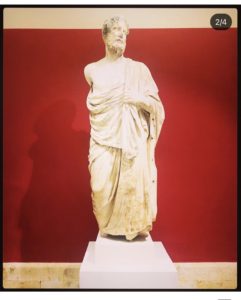
Following his tragic death, however, people started worshipping him as a God. And, God he became. To honor him, temples were built across Greece. Over 300 such temples (known as asclepieia) have been discovered throughout Greece and the Mediterranean. The asclepieia were more than temples and sanctuaries; they were also healing centers where people would go with the hope to get cured. And, of course, aspiring doctors would go there to learn the art of Medicine. Unsurprisingly, the most famous of these asclepieia, is the one in Kos. Other famous asclepieia are those of Trikka, Epidaurus, Athens, Corinth, and Pergamon.
Tip 1: Visit the Asclepieion
Built upon the slopes of a hill about a couple of miles west of Kos Town, the Asclepieion overlooks the Aegean with the Turkish coast on the background. Although it dates back to the fourth century BC, the ruins were only unearthed about a hundred years ago, at the beginning of the twentieth century.
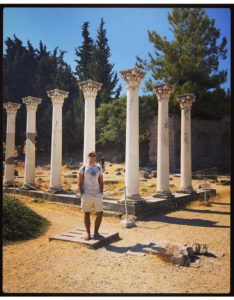
The entrance fee to the archaeological site of the Asclepieion costs 8 euros. A fun way to get there from Kos Town is to take the ‘mini-train’, which departs from the Dolphin Square.
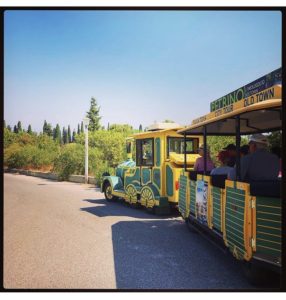
Tip 2: Visit the Archaeological Museum and the Casa Romana
The Asclepieion may be the most famous, but definitely not the only place of historical interest worth visiting.
In Kos Town, there’s the recently-renovated Archaeological Museum, located at Eleftherias Square, opposite the Municipal Market. The home of Hippocrates is housed in a two-story building, erected in 1935, at a time when Kos and the rest of the Dodecanese were still under Italian rule.
In the atrium, the floor mosaic depicts the arrival of Asclepios on the island. He is welcomed by other Gods and Goddesses, including Hygeia, who’s holding a snake in her right hand and an egg in her left. Hygeia, whose name means ‘health’ in Greek, was one of the Asclepiadae, the sons and daughters of Asclepios, the God of Medicine, and Epione, the Goddess of healing.
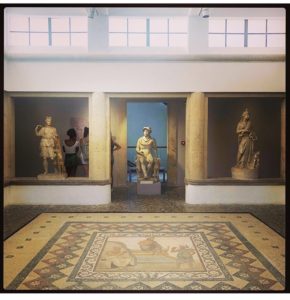
Dating back to the last third of the 4th century BC, the larger-than-life marble statue of Hippocrates stands tall at the very end of a large room full of other sculptures. When the museum was refurbished, some locals complained that Hippocrates was almost hidden among these other exhibits of much lesser importance.
The Casa Romana is within walking distance from the Archaeological Museum and also worth a visit. This is a restored Roman manor comprising 36 rooms and three atriums; it was built between the late 2nd and the early 3rd century A.D.
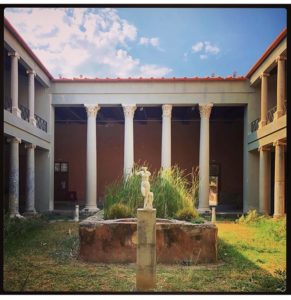
The entrance fee to both the Casa Romana and the Archaeological Museum costs 6 euros.
Tip 3: A walk in Kos Town
Kos Town showcases the rich and diverse history of the island. Walking around, you will come across two-thousand-year-old ancient Greek remnants and Roman buildings, Greek Orthodox churches, as well as mosques and minarets, and early-20th-century Italian buildings.
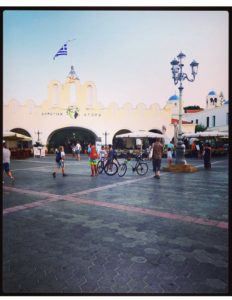
Opposite the Archaeological Museum, nestled between the red-domed Defterdar Mosque and the blue-domed Greek Orthodox Church of Agia Paraskevi, there’s the Municipal Market (Mercato delle Erne). This is a food market and the best place to buy traditional products, such as tomato spoon sweet (glyko ntomataki), tomato jam, wine cheese (krasotyri), and kanelada (a refreshing drink made from cinnamon).
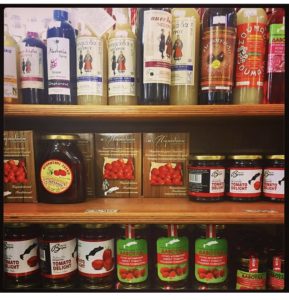
Afterwards, walk around the Old Town (İstanköy Eski Şehir), which used to be inhabited by the Turkish-speaking population of the island. Nowadays, it is home to shops, cafes, bars and restaurants.

From there, visit the Roman Odeon of Kos, an open-air Roman theater, dating to the 2nd century A.D. Continue towards the remnants of the 2nd-century-BC altar of Dionysus, before heading to the Plane Tree of Hippocrates, under which legend has it that the Father of Medicine taught his pupils. The Loggia Mosque, also known as the Mosque of Gazi Hassan Pasha, is right next to the famous tree. From there, walk back to Eleftherias Square, passing by the remnants of the Ancient Agora.
Tip 4: Go to the beach
Even though Kos Town is the main harbor as well as the latest settlement on the island, it is safe to swim there. I particularly enjoy swimming south of the harbor, in front of Avra, a beautiful beach bar nestled between the hotels Kos Aktis Art Hotel and Albergo Gelsonimo.
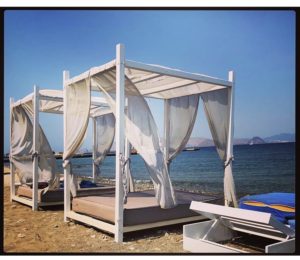
Alternatively, there’s Lambi Beach, on the north of the harbor. Lambi Beach is lined with many beach bars, Mylos Beach Bar being my favorite.
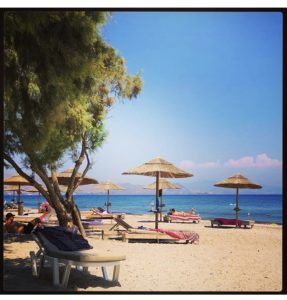
If you have a car, you should definitely go for a swim to Agios Stefanos, my favorite beach on the island. It is located on the southwest coast, about 40km from Kos Town (which is located on the northeast coast of the island). Once you get there, you will come across the ruins of an early Christian church, known as the Basilica of Agios Stefanos. Then, you will notice Kastri, a small rocky islet, just across the middle of the bay. The chapel of Agios Nikolas, built on this islet, is a good enough reason to swim to Kastri.
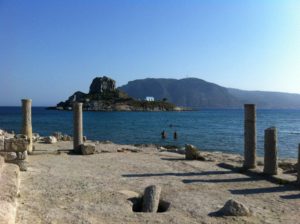
Tip 5: Watch the sunset in Ζia
Zia is an inland mountainous village, built on the slopes of Mount Dikaios. It is full of cafes, bars and restaurants offering panoramic views. The best (but also the most popular) time to visit Zia is in the evening; its location simply means that Zia is the perfect place on the island to watch the sunset from.
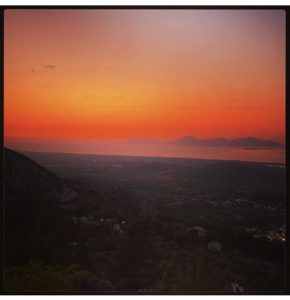
Tip 6: The Hippocratia Festival
If you visit the island in the summer, you will come across Hippocratia, a cultural festival named after the Father of Medicine. The festival line-up includes theatrical and dance performances, music concerts, and exhibitions, some of which take place at the Asklepieion.
Tip 7: Watch a film at Cine Orfeas
One of the things I love about Greece is watching a film in an open-air cinema on a warm summer night. There are many such cinemas around the country, both in the cities and the islands. Kos simply couldn’t be the exception. Cine Orfeas is located in Kos Town, between the harbor and the marina.
Tip 8: Where to eat and drink in Kos Town
Let’s start with breakfast. Established in 1952, Ariston is a small traditional cafe right next to the Archaeological Museum. It is renowned for its bougatsa (a traditional breakfast pastry made with phyllo and filled with custard) served with honey.
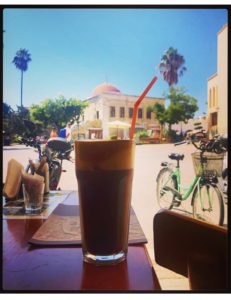
Avra is an excellent choice for light lunch; I had pancakes with cherry tomatoes, tomato jam, cream cheese and prosciutto, whilst relaxing right next to the sea. Their cocktails are also worth trying.
If you’d like something more substantial than a light lunch, I would recommend Ali, a family-run restaurant specializing in Turkish cuisine (in other words, go with an empty stomach and expect to eat a lot of meat). Alternatively, you can dine in one of the several taverns in Platani, a Turkish-populated village halfway between Kos Town and the Asklepieion.
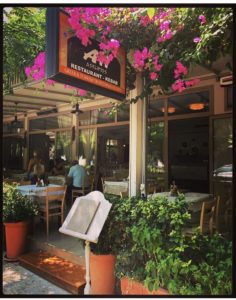
Cafe Neratzia, right next to the Plane Tree of Hippocrates, is perfectly-located for a coffee or even a drink (depending on the time of the day and your mood).
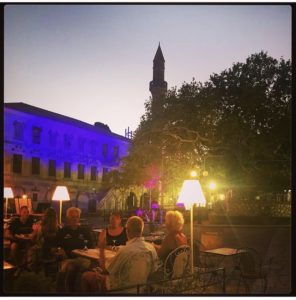
Alternatively, you can head to the seaside cafe-bar-restaurants of the hotels Kos Aktis Art Hotel or Albergo Gelsonimo.
For dinner, I would recommend Petrino, an elegant restaurant in Kos Town.
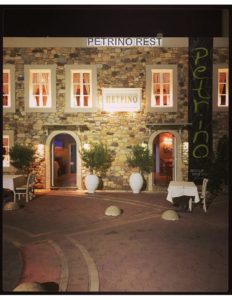
Alternatively, you can dine in Barbouni, a seafood restaurant right on the waterfront north of the harbor.

Afterwards, have ice cream at Special, right next to the Kos Aktis Art Hotel.

Tip 9: Go on a daily cruise to the neighboring islands
In the summer, there are daily cruises to the neighboring islands, such as Nisyros and Kalymnos.
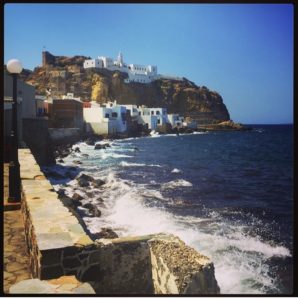
The boat to Nisyros departs from the port of Kardamena (on the south coast of Kos). It takes about an hour to reach the small volcanic island; the tour includes a visit to the monastery of Panagia Spiliani, and a visit to the crater of the volcano. I particularly enjoyed walking in Mandraki, which is the capital and the largest settlement, as well as the harbor of the island. I specifically remember the seafront cafes, best places to enjoy a refreshing glass of soumada, the island’s signature drink made from almonds.
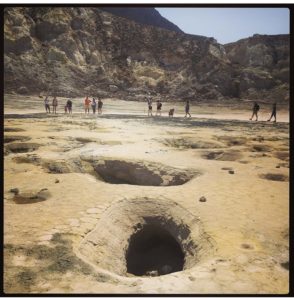
The boat to Kalymnos departs from Kos Town. This island is famous for its sponge divers. Kalymnos Town has a very picturesque harbor, lined with cafes and patisseries. Michalaras’ Patisserie is famous for the galaktoboureko (custard baked in phyllo, drenched in syrup). The so-called ‘three island cruise’ also includes a visit to the tiny island of Pserimos, and swimming in the crystal-clear waters near the uninhabited island of Platy.
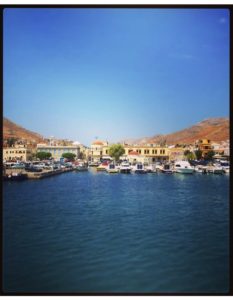
In addition to the cruises to Nisyros and Kalymnos, there are also regular services to Bodrum, on the Turkish coast. The boats to Bodrum also depart from Kos Town.
Practical information
How to get to Kos
There are direct seasonal flights to Kos from many European airports, as well as daily flights from Athens. Once you arrive, you may want to rent a car, as driving is the easiest way to get to Zia and to Agios Stefanos.
When and how long to visit Kos
For me, the best time to visit the Greek islands is the summer; this is when the ferries are at their most frequent, the weather at its warmest and the atmosphere at its best. Having said that, early autumn is also a good time to visit Kos, as the island doesn’t shut down come September and the weather remains summer-y.
If you want to combine your holiday in Kos with daily cruises to the neighboring islands, I would recommend staying in Kos for at least a week.
Accommodation in Kos
I would strongly recommend staying in Kos Town. The hotels Triton, Kos Aktis Art Hotel and Albergo Gelsonimo are on the waterfront, whereas Maritina overlooks the remnants of the 2nd-century-BC altar of Dionysus.
Further reading
When I visited Kos last year, I bought a jar of tomato spoon sweet (glyko ntomataki) and a jar of tomato jam. When I returned home, I came up with the idea for a sweet tomato cheesecake, a perfect way to showcase these wonderful ingredients. Check out my recipe here.
“If we could give every individual the right amount of nourishment and exercise, not too little and not too much, we would have found the safest way to health.”
Hippocrates
Alex
(the-Traveling-again-Psychiatrist)